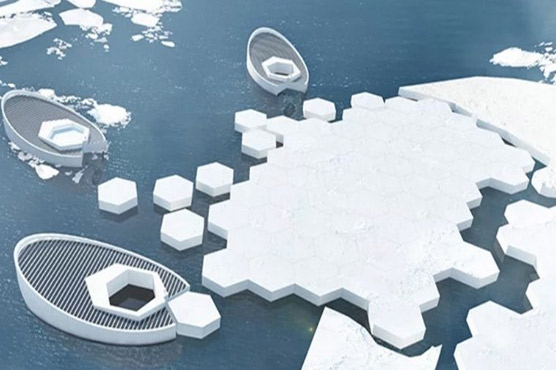Researchers plan submarine for 're-iceberg-isation' in Arctic

But to actually have that effect, the scale of this project would have to be immense.
(Web Desk) – In a desperate attempt to re-freeze the Arctic, designers have proposed a wacky and futuristic iceberg-making submarine. By bringing together a fleet of these huge vessels, the team hopes to create new ice fields that will ultimately help balance polar ecosystems.
The radical geo-engineering proposal was recently awarded second prize in an international competition organised by the Association of Siamese Architects. But while the idea is a fun thought experiment, its actual feasibility remains dubious.
Over the past three decades, the Arctic Ocean has lost 95 percent of its oldest and most durable ice. This extreme melting event, triggered by the climate crisis, has placed Arctic food chains in grave danger, forcing seals, fish, wolves, foxes and polar bears into ever smaller ranges.
Inspired by the benefits of re-forestation, the team thinks their prototype could help save these habitats, leading to what they call “re-iceberg-isation” in the Arctic.
According to designs, the vessel would work by re-freezing Arctic sea-water into hexagon-shaped icebergs - each about 2,027 cubic metres (535,477 gallons) - which would ultimately cluster together to form new ice floes.
First, the designers explain, the floating submarine would sink under the surface, collecting sea water in a shaded tank.
Next, some of that salt would be extracted using a system of reverse osmosis, which would make it easier to freeze.
Through the use of air turbines, the remaining sea water would then be frozen into a hexagon-shape iceberg and released back into the ocean after a month.
"The main goal of this idea is to restore the polar ecosystem, which has a direct effect on the balance of the global climate," said team member and Indonesian designer Faris Rajak Kotahatuhaha, according to Dezeen.
Kotahatuhaha acknowledges that the idea will not stop climate change or reduce emissions, but he and his colleagues think that rebuilding lost sea-ice could help provide rich habitats and hunting platforms.
As reasonable as this sounds, there’s also reason to be skeptical. In a video for the new prototype, the designers appear to claim their idea will somehow prevent further sea level rise.
But to actually have that effect, the scale of this project would have to be immense.
Contrary to what many assume, melting sea ice does not contribute to sea level rise; these icebergs are, after all, already floating in the ocean. The real threat is from melting land ice which flows into the ocean; this means that newly created icebergs would have to somehow end up on land to really make a difference.
Further, while it’s true that shiny icebergs can help shade ocean waters - reflecting some of the Sun’s energy and blocking absorption - to make a big-enough impact, these new ice floes would have to cover huge swathes of the polar ocean.
Commenting on the proposal, atmospheric scientist Michael Mann told NBC News: "It’s like trying to save the sand castle you built at the beach using a dixie cup as the tide comes in."
Above and beyond sea levels, there are also other doubts. It’s currently unclear how these submarines will be powered and whether enough wind energy can be gathered to freeze their immense gulps of water.
If the energy source on these vessels isn’t green and renewable, they’d simply be adding to global emissions. When it comes to preventing sea level rise and biodiversity loss in the Arctic, unequivocally, our best solution remains to cut down on our emissions.


